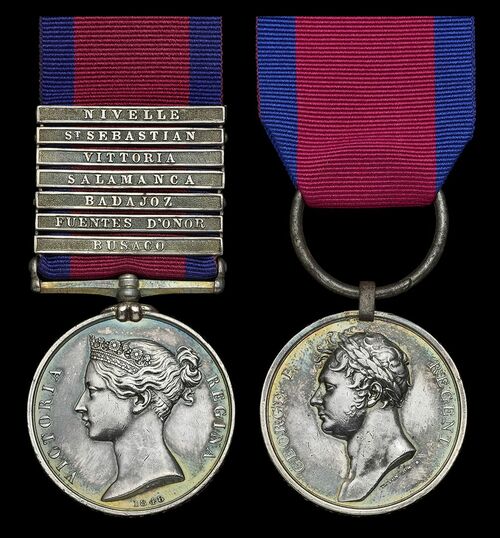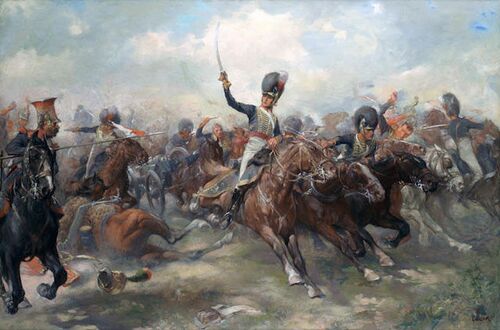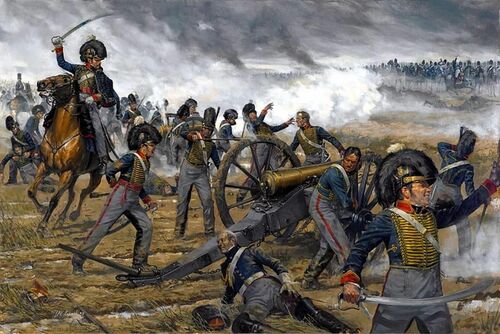Auction: 24001 - Orders, Decorations and Medals
Lot: 59
The superb and regimentally unique campaign pair awarded to Staff Sergeant (late Troop Sergeant-Major) N. Moore, 'I' Troop, Royal Horse Artillery, a long-serving veteran who participated in all his Battery's most famous actions during the Napoleonic Wars
Waterloo 1815 (Staff Serj. Nich. Moore, Royal Horse Artillery.); Military General Service 1793-1814, 7 clasps, Busaco, Fuentes d'Onor, Badajoz, Salamanca, Vittoria, St. Sebastian, Nivelle (N. Moore, Tp. Serjt. Majr. R. H. Arty.), minor contact marks to fields, otherwise very fine (2)
A unique combination of clasps to the Royal Horse Artillery, and one of only two men in 'I' (Bull's) Troop R.H.A. with the rank of Staff Sergeant at the Battle of Waterloo.
Nicholas Moore, a Labourer from Kyloe in Northumberland, enlisted with the Royal Horse Artillery in April 1794 at the age of 18 and must therefore have been one of the regiment's earliest recruits as the R.H.A. had only been raised in January the previous year. Moore was clearly a steady, reliable and able soldier and rose through the ranks to become Troop Sergeant-Major by the time the unit was deployed to the Iberian Peninsula in 1810. Straight into action and with Captain Robert Bull at their head, the Troop saw significant service until the conclusion of the war in 1814 and fought in no less than 43 minor engagements in addition to eight pitched battles and sieges - undoubtedly Moore must have witnessed most of these, and in a position of significant responsibility as the senior Non-Commissioned Officer present. Evidence of the Troop's gallant conduct can be observed from the multiple occasions they were 'mentioned' in official correspondence: in Cavalry Division Orders, 6 October 1810, they received the thanks of Sir Stapleton Cotton: "for the zeal and activity displayed on the 5th October, 1810, and at all times during the retreat from the frontier." Wellington himself mentioned them in his Despatches of 16 March and 2 April 1811 for good work during three minor actions; and they earned yet another 'mention' on 7 April for services during two further skirmishes.
Undoubtedly however, the Troop's finest moment (and one which has gone down in the annals of military history) came during the Battle of Fuentes de Onoro (3 - 5 May 1811): whilst under the temporary command of Lieutenant Norman Ramsay (himself a renowned R.H.A. officer later to be killed at Waterloo) and supporting the withdrawal of the 7th Division, they were surprised and charged by French cavalry. Feared lost, amidst the dust and confusion, all of a sudden the Troop charged out of the melee with guns limbered up and the men using their sabres against the enemy horsemen. Successfully reaching the protection of the 7th Division, a great shout of joy was heard amongst all ranks as the artillerymen galloped in to safety - Moore being one of their number to survive this gallant dash. This unique act was later immortalised in the famous painting 'Captain Norman Ramsey, R.H.A. saving the guns of Bull's troop at the battle of Fuentes de Oñoro 5th May 1811'. The unit's exceptional cohesion and veteran status was later remarked upon by the overall artillery commander, Sir Augustus Frazer, who stated in a letter in 1813: ...'two days after the battle of Vitoria, in which Bull's troop (which I have no hesitation in saying is much the best in this country) had, under Ramsay's command, been of unusual and unquestionable service.' (Letters of Colonel Sir Augustus Simon Frazer K.C.B., Commanding the Royal Horse Artillery in the Army under the Duke of Wellington, written during The Peninsular and Waterloo Campaigns, London, 1859, p. 186 refers).
The Waterloo Campaign
Remaining with his Troop after the end of the Peninsular War, Moore, Bull and the rest of the unit were next mobilised for service in Belgium during the Waterloo Campaign and, uniquely for any Allied battery present in Belgium, they were equipped entirely with six 5.5in howitzers rather than the usual complement of five 6- or 9-pounder guns and one howitzer. This made them somewhat of a specialist unit much in demand for particular services - not least during the famous defence of Hougoumont. When the vast French infantry attacks against the fortified chateau began, Bull's Troop were called upon to use their howitzers from the ridge behind the farmhouse to provide indirect fire onto the heads of the enemy infantry. Frazer again takes up the story:
'In a moment Bell was sent for the howitzer troop (Bull's), and I rode up and told the Duke I had done so. By this time the enemy had forced a Belgian battalion out of the orchard to the left of the wood, and there was a hot fire on a battalion (or four companies, I forget which) of the Guards, stationed in the buildings and behind the walled garden. The howitzer troop came up, and came up handsomely; their very appearance encouraged the remainder of the division of the Guards, then lying down to be sheltered from the fire. The Duke said, "Colonel Frazer, you are going to do a delicate thing; can you depend upon the force of your howitzers? Part of the wood is held by our troops, part by the enemy," and his Grace calmly explained what I already knew. I answered that I could perfectly depend upon the troop; and, after speaking to Major Bull and all his officers, and seeing that they, too, perfectly understood their orders, the troop commenced its fire, and in ten minutes the enemy was driven from the wood.' (ibid, p.556).
This texbook example of plunging fire, with fuzes on their shrapnel shells perfectly timed to explode above the advancing French infantry to deadly effect, drew praise from all who witnessed it - including Wellington himself. As one of the two most senior N.C.O.'s in the Troop at this time, and a man with significant combat experience, Moore must surely have yet again played a significant part in making it all happen. Such was the rate of fire that their guns brought down upon the enemy, that they later had to withdraw behind the Allied line to allow them to cool down. Moore was discharged in 1816 after service of 21 years and 344 days (with two years' extra credit for Waterloo) and is noted as claiming a pension of 2s/1d per diem in 1861; he died in 1863.
Sold with copied Discharge papers, a copied extract of Major-General Siborne's 'Waterloo Letters' detailing the activities of Bull's Troop at Waterloo, and a typed note (perhaps circa 1960's) stating:
'These medals were earned by my Great-grandfather on my father's side, Nicholas Moor [sic], the son of a farmer at Berrington, nr. Beal. He was born in 1777. Against all the wishes of his family he suddenly left his horses outside the Old Angel Inn, in High St., Berwick, one day and went off to join the Army. When the Royal Horse Artillery was formed, he was selected for a position, and he fought with Colonel Bull and the famous Norman Ramsay throughout the Peninsular War and the Battle of Waterloo, after which he retired on a well-earned pension. He spent the remainder of his days at Castlegate, Berwick, and died in 1863. He was Sergt. Major of the famous 'I' troop when Norman Ramsay dashed through the French Cavalry at Fuentes D'Onoro, a feat which cost the gallant officer his sword, but the brave deed brought undying fame to the 'I' troop, which despite reforms and changes remains 'I' troop in honour of this event. Nicholas Moor [sic] served in Ireland in 1798, and at Moelle, St. Sebastian, Salamanca, Badajoz, Fuentes D'Onoro, Vittoria, Busaco and Waterloo.'
Subject to 20% VAT on Buyer’s Premium. For more information please view Terms and Conditions for Buyers.
Sold for
£3,800
Starting price
£3000









